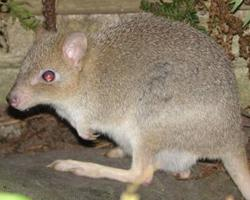
Váhy a míry
| Délka | 31,5 33,5 |
|---|---|
| Hmotnost | od 1,2 do 2,2 kg |
Stav ohrožení
| Ohrožen |
Popis zvířete
The Eastern Bettong (Bettongia gaimardi), a small, intriguing marsupial, is an essential part of Australia's unique biodiversity. This nocturnal creature, often described as resembling a miniature kangaroo, plays a crucial role in the ecosystem it inhabits. Despite its kangaroo-like appearance, the Eastern Bettong is much smaller, typically weighing between 1.5 to 2.5 kilograms. Its fur is predominantly grey-brown, providing excellent camouflage against the forest floor, while its underbelly is usually a lighter cream color.The Eastern Bettong possesses a number of adaptations that make it well-suited to its environment. It has powerful hind legs that allow for rapid, bounding movements, enabling it to escape predators and move efficiently in search of food. Its long, thin tail, which can be as long as its body, is not prehensile but is used for balance and support when sitting upright. Additionally, the bettong has a pouch in which females carry and nurse their young, a characteristic feature of marsupials.
One of the most fascinating aspects of the Eastern Bettong is its diet and foraging behavior. Primarily mycophagous, these animals have a diet that heavily relies on fungi, including truffles. They play a vital role in their ecosystems by dispersing spores through their droppings, thereby aiding in the regeneration of their habitat. Besides fungi, their diet also includes roots, tubers, seeds, and occasionally insects, which they forage for using their keen sense of smell.
Historically, the Eastern Bettong was found throughout southeastern Australia. However, due to a combination of habitat destruction, predation by introduced species such as foxes and cats, and competition with livestock and other non-native animals, their numbers have drastically declined. Today, the Eastern Bettong is extinct on the mainland of Australia and is now only found in the wild in Tasmania. Conservation efforts are underway to protect this species, including habitat restoration and the establishment of predator-free reserves.
Breeding in Eastern Bettongs occurs throughout the year, with females capable of giving birth to up to three joeys per year. The young are born extremely undeveloped and crawl into the mother's pouch, where they continue to develop for around four months. After leaving the pouch, joeys remain dependent on their mother for a few more months before becoming independent.
The conservation status of the Eastern Bettong highlights the fragile balance of ecosystems and the impact of human activity on native species. Conservation initiatives for the Eastern Bettong not only aim to protect this unique marsupial but also serve as a reminder of the importance of preserving natural habitats and biodiversity. Through such efforts, there is hope that the Eastern Bettong can be reintroduced to its former range and thrive once again in the wild.
Nové fotografie zvířat
Top 10 zvířat
- Chinese water dragon (Physignathus cocincinus)
- Galápagos tortoise (Geochelone nigra complex)
- Dolphin gull (Leucophaeus scoresbii)
- Japanese macaque (Macaca fuscata)
- Colombian red howler (Alouatta seniculus)
- Sea urchins (Echinoidea)
- Moustached guenon (Cercopithecus cephus)
- Diana monkey (Cercopithecus diana)
- Common reed warbler (Acrocephalus scirpaceus)
- Common house mosquito (Culex pipiens)